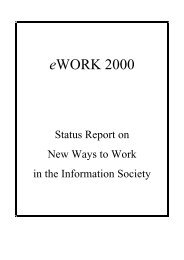Proceedings of 8th European Assembly on telework (Telework2001)
Proceedings of 8th European Assembly on telework (Telework2001)
Proceedings of 8th European Assembly on telework (Telework2001)
You also want an ePaper? Increase the reach of your titles
YUMPU automatically turns print PDFs into web optimized ePapers that Google loves.
165Table 2:Tele-cooperati<strong>on</strong> in Europeworkers who tele-cooperate as % <str<strong>on</strong>g>of</str<strong>on</strong>g>all workersregularly(in %)occasi<strong>on</strong>ally(in %)not(in %)Self-employed workers who telecooperateas % <str<strong>on</strong>g>of</str<strong>on</strong>g> all self-employed 2regularly(in %)occasi<strong>on</strong>ally(in %)not(in %)Denmark 26.0 5.9 68.1 35.7 0.0 64.3Finland 43.4 6.9 49.7 40.5 0.0 59.4France 21.7 4.8 73.5 10.7 3.6 85.8Germany 26.8 5.3 67.9 13.6 9.8 76.7Ireland 32.1 5.4 62.5 16.6 6.5 76.8Italy 17.6 9.8 72.6 9.7 11.7 78.6Netherlands 29.9 15.5 54.6 20.0 28.9 51.2Spain 19.7 4.2 76.1 12.7 6.4 81.0Sweden 29.9 7.9 62.2 21.0 16.3 62.7U.K. 37.5 5.2 57.3 14.7 1.7 83.6EU10 28.2 6.7 65.1 13.6 8.1 78.3Data source: ECaTT 1999 (n=3,895), see Gareis 2001This means that there is no sign that a significant share <str<strong>on</strong>g>of</str<strong>on</strong>g> today’s self-employed freelancers willc<strong>on</strong>vert into e-lancers any time so<strong>on</strong>, as they have not even started making use <str<strong>on</strong>g>of</str<strong>on</strong>g> the most basictools <str<strong>on</strong>g>of</str<strong>on</strong>g> electr<strong>on</strong>ic collaborati<strong>on</strong>. One should also be careful before taking other trends towardsgreater flexibility in work organisati<strong>on</strong> as precursors <str<strong>on</strong>g>of</str<strong>on</strong>g> a dissoluti<strong>on</strong> <str<strong>on</strong>g>of</str<strong>on</strong>g> employment relati<strong>on</strong>shipsinto an eLancing labour force.It is true that ICTs have enabled increases in flexibility in all <str<strong>on</strong>g>of</str<strong>on</strong>g> the main categories <str<strong>on</strong>g>of</str<strong>on</strong>g> change(time, place, c<strong>on</strong>tract and work c<strong>on</strong>tent). With regard to working time, companies now <str<strong>on</strong>g>of</str<strong>on</strong>g>fer/demand models that are much more variable and adapted to the requirements <str<strong>on</strong>g>of</str<strong>on</strong>g> workers and/orthe company than they have been in the past. However, the more these measures enhance internalflexibility, the less companies need to revert to raising external flexibility through outsourcing<str<strong>on</strong>g>of</str<strong>on</strong>g> activities to subc<strong>on</strong>tractors or freelancers (Bosch 2000). The working time situati<strong>on</strong> <str<strong>on</strong>g>of</str<strong>on</strong>g> thedependent employed workers gradually becomes more similar to that <str<strong>on</strong>g>of</str<strong>on</strong>g> the self-employed. Thisshould not be interpreted, however, as a sign that employee status is eroding. It indicates rather thatdependent employment arrangements are adapting to new requirements.With regard to the type <str<strong>on</strong>g>of</str<strong>on</strong>g> c<strong>on</strong>tract, own-account self-employment (without employees) is obviously<strong>on</strong> the rise, but c<strong>on</strong>tinues to employ <strong>on</strong>ly a small minority <str<strong>on</strong>g>of</str<strong>on</strong>g> the total labour force. The fact thatthe highest shares <str<strong>on</strong>g>of</str<strong>on</strong>g> own account self-employed are to be found in the less developed EU MemberStates indicates that most <str<strong>on</strong>g>of</str<strong>on</strong>g> these workers are in pers<strong>on</strong>al services and trade rather than in theknowledge ec<strong>on</strong>omy. The share <str<strong>on</strong>g>of</str<strong>on</strong>g> self-employed workers who are engaged in activities which aresuitable for e-lancing is most certainly very small.There is <strong>on</strong>ly limited evidence that temporary work can be regarded as a first step towardsoutsourcing work to freelancers. It is being used to employ special labour market participants








